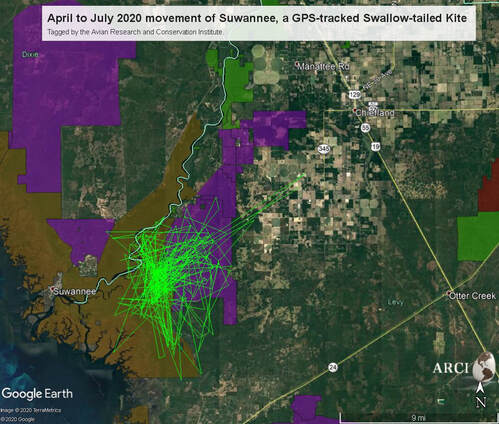|
A much-anticipated report from Gina Kent, Senior Conservation Scientist from Avian Research and Conservation Institute (ACRI) in Gainesville, indicates that Suwannee's movements were almost entirely monitored from afar this season due to travel restrictions. It appeared that in April he was using and visiting a centralized location near his 2019 nest. Clusters of GPS locations inferred that there was most likely a nest attempt. By May, he had not returned to that location. This was all in a timeframe that was too short to raise and fledge young. Further investigations by USFWS's Larry Woodward and later by ARCI, revealed an empty nest. Cause of failure unknown. Meanwhile, Suwannee continues to do well and has stayed close within the bounds of the Refuge and the neighboring conservation easement areas to the east. His travels, starting in early July, have led to trips east and northeast to surrounding agricultural fields, most likely filled with bugs. This is the time of year all kites need to fatten up for their 5,000-mile trip to South America for the winter. If you’re interested in catching a glimpse of Suwannee and your travels can safely take you through the agriculture fields southwest of Chiefland, perhaps you will find a foraging aggregation of Swallow-tailed Kites. Keep your eye out for one with a "bump" on its back and maybe you'll see our celebrity kite. If you do, please report it to ARCI on the "Report Sightings" page of their website www.arcinst.org. This tracking program is funded by Friends and additional monies are necessary to keep it going. One way income is raised is through the sale of Suwannee t-shirts. There is a limited supply, but the inventory will be replenished as needed. For more information, contact Friends board member Debbie Jordan at [email protected]
0 Comments
Leave a Reply. |
Archives
June 2024
|

Friends of the Lower Suwannee & Cedar Keys National Wildlife Refuges
P. O. Box 532 Cedar Key, FL 32625 [email protected] We are a 501(c)(3) nonprofit organization. |
|
